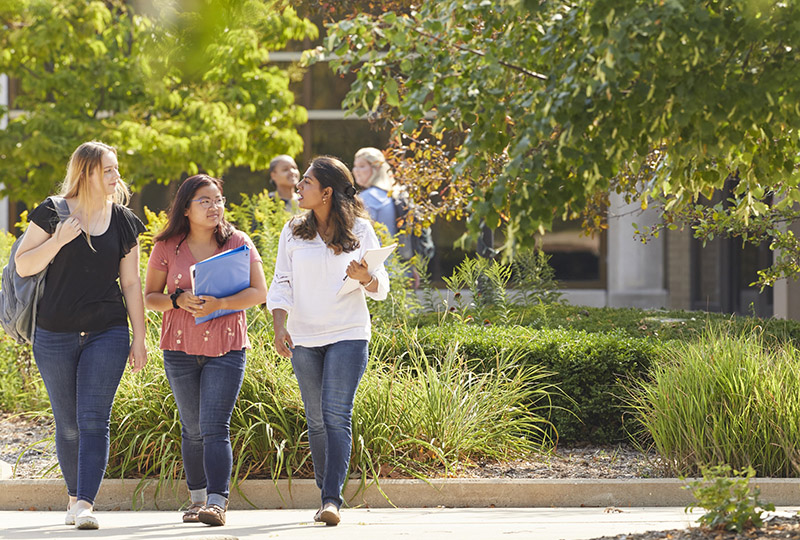
Many of the communities that Alverno College serves have seen a decrease in college attendance rates across the board. The school is combatting that with ambitious capital projects. (Photo courtesy of Alverno College)
Larry Hanson
Catholic Herald Staff
Institutions of higher learning — specifically Catholic colleges and universities — are adapting to a changing landscape that gives no signal of where it’s headed next.
Costs, declining enrollments and a workforce that is transforming have forced Wisconsin’s Catholic colleges to become creative and resourceful in dealing with the challenges that lie ahead.
“The changing landscape in higher education has made it more challenging for small religious-based institutions to thrive,” said Mount Mary University President Isabelle Cherney. “Fewer students are choosing to attend college, and many young people are taking a nontraditional route into the job market.”
That abstract concept became a stark reality on Monday, April 10, when Cardinal Stritch University in Fox Point announced it was closing its doors at the end of this semester.
The three remaining Catholic institutions in the Milwaukee area — Alverno College, Mount Mary University and Marquette University — have been planning for the shifting landscape for years with campus improvements, fundraising campaigns and innovative new programs.
“Smaller, private institutions can also be nimble and proactively implement new approaches,” Marquette University President Michael Lovell said. “We can try new things, get fast feedback and figure out what’s going to work best for our students.”
Some of the factors that have created lower enrollments and tightening budgets include the Great Recession of 2008-10, which saw decreased birth rates; the COVID-19 pandemic, which was a disruption to so many industries; and changing attitudes toward the value of a college education.
“At Marquette University, we’re emphasizing how the value of a four-year degree contributes to upward mobility and how the connections established here as a student set our graduates up for career success after graduation,” Lovell said. “We’re trying to tell this story as much as possible, sharing examples of how we prepare students to thrive as agents of positive change, capable of transforming their fields and society.”
An extenuating circumstance at Alverno is many of the communities it serves (including first-generation students and Pell Grant eligible students) have seen a decrease in college attendance rates across the board, according Kate Lundeen, the college’s Vice President for Enrollment and Marketing.
Marquette University has taken major steps in recent years to transform its campus, including a new student success center, a wellness and recreation facility, and a state-of-the-art college of business administration. The college is creating strategic partnerships to prepare students for jobs that may not even exist yet.
Marquette’s undergraduate enrollment has decreased by 987 students since the 2019-20 school year, from 8,515 to 7,528.
Marquette has also raised $665 million of $750 million goal for its multi-year Time to Rise fundraising campaign.
Among the capital improvements made at Alverno College are the Thea Bowman Institute for Excellence and Leadership, the Alverno Greenhouse, the Center for Academic Excellence, and the Research Center for Women and Girls.
The Thea Bowman Institute is a cohort model, full-scholarship program for Black undergraduates who have a strong desire to serve as leaders. The greenhouse is a state-of-the-art aquaponics facility that sustainably grows plants, vegetables and perch, offering students an opportunity to engage in hands-on learning, participate in research projects, and explore new career paths in science, food, urban agriculture, water research, conservation and human services industries. The Research Center for Women and Girls is devoted to taking scholarly research that applies to the real world, where it can inspire, transform and support initiatives that improve the lives of women and girls in Wisconsin and beyond.
Mount Mary University has actually seen an increase in its undergraduate population since the 2019-20 academic year, growing from 641 students to 647.
Despite the slight increase in students, Cherney said the university is facing the same issues as its counterparts.
“Mount Mary University has not been exempt from these issues,” Cherney said. “Mount Mary has been proactive with a major focus on enrollment growth through new programs, stronger retention and diversification of revenue. Mount Mary continues to be rated among the most successful institutions in the Midwest for graduating diverse and low-income students, and in providing value for all students regardless of their background.”
